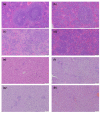Infection Route Impacts the Pathogenesis of Severe Fever with Thrombocytopenia Syndrome Virus in Ferrets
- PMID: 35746656
- PMCID: PMC9227493
- DOI: 10.3390/v14061184
Infection Route Impacts the Pathogenesis of Severe Fever with Thrombocytopenia Syndrome Virus in Ferrets
Abstract
The threat of severe fever with thrombocytopenia syndrome (SFTS) to public health has been increasing due to the rapid spread of the ticks that carry the causative viral agent. The SFTS virus (SFTSV) was first identified in China and subsequently detected in neighboring countries, including South Korea, Japan, and Vietnam. In addition to the tick-mediated infection, human-to-human transmission has been recently reported with a high mortality rate; however, differential study of the pathogen has been limited by the route of infection. In this study, we investigated the pathogenic potential of SFTSV based on the infection route in aged ferrets, which show clinical signs similar to that of human infections. Ferrets inoculated with SFTSV via the intramuscular and subcutaneous routes show clinical signs comparable to those of severe human infections, with a mortality rate of 100%. Contrastingly, intravascularly infected ferrets exhibit a comparatively lower mortality rate of 25%, although their early clinical signs are similar to those observed following infection via the other routes. These results indicate that the infection route could influence the onset of SFTS symptoms and the pathogenicity of SFTSV. Thus, infection route should be considered in future studies on the pathogenesis of SFTSV infection.
Keywords: SFTSV; aged ferret; animal model; infection routes.
Conflict of interest statement
The authors declare no conflict of interest.
Figures



Similar articles
-
Severe Fever with Thrombocytopenia Syndrome, a Viral Hemorrhagic Fever, Endemic to Japan: Achievements in and Directions for Medical Research.Jpn J Infect Dis. 2022 May 24;75(3):217-227. doi: 10.7883/yoken.JJID.2021.851. Epub 2022 Mar 31. Jpn J Infect Dis. 2022. PMID: 35354707
-
A Patient with Severe Fever with Thrombocytopenia Syndrome (SFTS) Infected from a Sick Dog with SFTS Virus Infection.Jpn J Infect Dis. 2022 Jul 22;75(4):423-426. doi: 10.7883/yoken.JJID.2021.796. Epub 2022 Feb 28. Jpn J Infect Dis. 2022. PMID: 35228501
-
Modeling Severe Fever with Thrombocytopenia Syndrome Virus Infection in Golden Syrian Hamsters: Importance of STAT2 in Preventing Disease and Effective Treatment with Favipiravir.J Virol. 2017 Jan 18;91(3):e01942-16. doi: 10.1128/JVI.01942-16. Print 2017 Feb 1. J Virol. 2017. PMID: 27881648 Free PMC article.
-
Pathophysiology of severe fever with thrombocytopenia syndrome and development of specific antiviral therapy.J Infect Chemother. 2018 Oct;24(10):773-781. doi: 10.1016/j.jiac.2018.07.009. Epub 2018 Aug 8. J Infect Chemother. 2018. PMID: 30098914 Review.
-
[Severe fever with thrombocytopenia syndrome: epidemiology, pathophysiology, and development of specific treatment and prevention measures].Rinsho Ketsueki. 2018;59(10):2255-2259. doi: 10.11406/rinketsu.59.2255. Rinsho Ketsueki. 2018. PMID: 30305533 Review. Japanese.
Cited by
-
Age-associated immune dysregulation and B cell dysfunction drive severe outcomes in SFTSV infection.PLoS Pathog. 2025 Aug 12;21(8):e1013402. doi: 10.1371/journal.ppat.1013402. eCollection 2025 Aug. PLoS Pathog. 2025. PMID: 40794649 Free PMC article.
References
-
- Takahashi T., Maeda K., Suzuki T., Ishido A., Shigeoka T., Tominaga T., Kamei T., Honda M., Ninomiya D., Sakai T. The first identification and retrospective study of severe fever with thrombocytopenia syndrome in Japan. J. Infect. Dis. 2013;209:816–827. doi: 10.1093/infdis/jit603. - DOI - PMC - PubMed
Publication types
MeSH terms
Supplementary concepts
LinkOut - more resources
Full Text Sources

